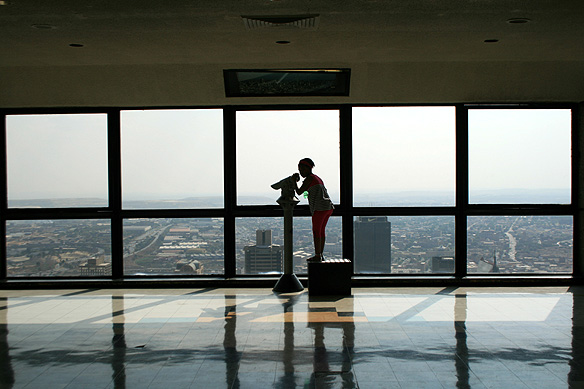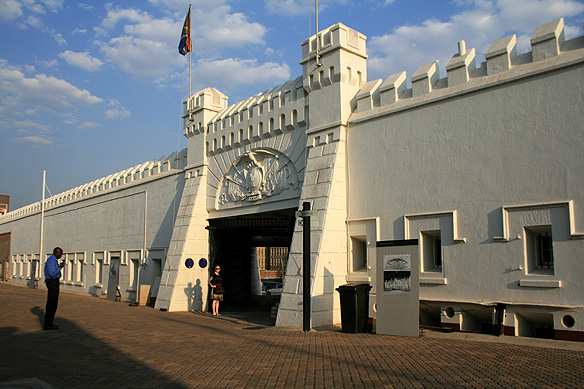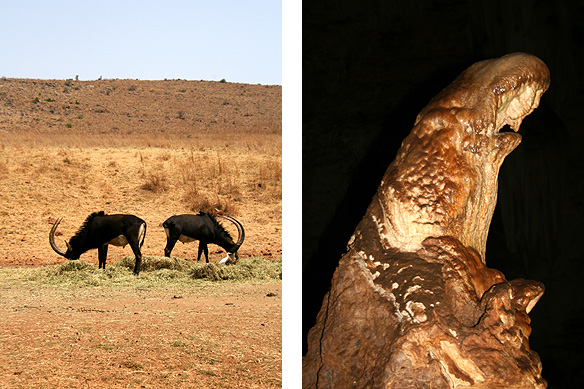Gauteng, place of gold
Four whole days in Gauteng! I’m a very happy woman. Yes, trust me, there is a lot to see and explore in this concrete jungle that is South Africa’s economic powerhouse. Gauteng actually means ‘place of gold’, a name that is evocative of its history and reason to be. The smallest yet wealthiest province in the country, covering a mere 1.4 percent of its total land area, Gauteng contributes 33.9 percent to South Africa’s GDP and 10 percent to the whole African continent’s GDP. In historical terms its name traces back to the discovery of gold in 1886 in Johannesburg.
I used to live here at one time and enjoyed it fully, that is apart from the traffic which is absolutely crazy. I know, everyone talks about the crime. I have, touchwood, never had a bad experience. And things are even better now with neighbourhood watches, plain-clothes police, and security cameras. Here is my take on Gauteng, not as a resident, but as a traveller. 🙂
Pretoria, the Capital
My travels in the province start with Pretoria, the de facto national capital and a city steeped in Afrikaner history. Pretoria has always been a capital, since its founding in 1855 by Marthinus Pretorius, leader of the Voortrekkers, who named it after his father. The Voortrekkers were the heroes of Afrikanerdom.
In rebellion against British occupation, bands of Dutch farmers—the Voortrekkers or ‘pioneers’—left the cape in ox wagons between 1834 to 1854 together with their wives, children and servants to make the Great Trek across the interiors, beyond the Orange and Vaal rivers, and the Drakensberg mountains to eventually set up their own independent Boer Republics. On the way they suffered many hardships and fought numerous battles against the indigenous Zulus that they encountered, tales which live on in Afrikaner literature and the 27 bas relief panels in the Hall of Heroes in the majestic Voortrekker Monument (1949).
The modest Kruger House, once the home of Paul Kruger, president of the South African Republic and leader of the Boer resistance against British imperialism during the South African or Anglo-Boer War (1899-1902), was a lovely surprise. Homely and simple, it has been kept intact as it once was.
Pretoria is rich in Victorian architecture with many fine buildings clustered around Church Square. Its best example, however, is the stately Union Buildings designed by Sir Herbert Baker. The perfectly symmetrical edifice was built in 1910 to celebrate the Union of South Africa, yet another chapter in the country’s history in which universal suffrage was excluded. In 1994, Nelson Mandela gave his inaugural speech as the president of South Africa here and Pretoria this time around became the seat of independent, Republic South Africa’s government.

The Afrikaner Voortrekker Monument and bust of Paul Kruger, State President of the South African Republic and leader of the Afrikaner people.
Mandela’s Soweto

Self-portrait: Looking into the windows of Nelson Mandela’s house in Soweto.
The one place every tourist to South Africa wants to [and should] visit is Soweto or South Western Townships [its full name]. Soweto is the by-product of the discovery of gold in the area, the subsequent garnering of black labour to work in the mines, and the Group Areas Act of apartheid which forcibly removed blacks from the city centre and placed them on its fringes.
Visiting Soweto is an experience in itself. With a population of 3 million, it is immense, setting trends in black fashion, music, sports and politics. Its most famous street is Vilakazi where two noble prize winners had their homes, but a few yards from each other—Nelson Mandela and Desmond Tutu.
The township’s main claim to fame in the international arena is the role it played in the fight against apartheid, particularly the Soweto Uprising on 16 June, 1976 and the shooting dead of the 12-year-old child, Hector Pieterson, by the apartheid police which created a worldwide outrage against the atrocities being carried out within the country. The memorial site and museum dedicated to these events are raw and painful in their depictions. It seemed impossible not to get a lump in my throat or for my eyes to mist over. For a lighter note, I found Soccer City, loud music, and an incredibly close-knit community which gives Soweto its much-needed strength and resilience.


A typical snack bar shop on Vilakazi, Soweto’s most famous street which houses the homes of two noble prize winners and leaders of the anti-apartheid struggle: Nelson Mandela and Desmond Tutu.
Jo’burg, Egoli aka Johannesburg
Jozi, Jo’burg, Egoli are but various names South Africans fondly call Johannesburg by. Jo’burg [which is what I call it] is multifaceted: steel and glass, freeways, splendid malls, elegant neighbourhoods, the trademark gold mine dumps, a chaotic downtown, hours in the traffic, beautiful weather, and people from every part of the world and all parts pf the country. Dig just a little bit, and there is also history, art, great food, award-winning museums and regular performances by international and local artists. It is a world city with world-class amenities and infrastructure and its airport is my favourite.
Johannesburg is not an old city. It was founded in 1886 following the discovery of gold by the surveyor George Harrison, and grew rapidly from a dusty settlement strewn with tents to what it is now. I had a tough time trying to find a city tour! I eventually managed to find one and went up to the 50th floor of the Carlton Centre in downtown for gorgeous views of the city, explored Constitutional Hill with its prisons and the Constitutional Court of the new South Africa which gives all its people equal human rights, and stopped by Mandela’s house in Houghton. No, we didn’t go in for tea. 😉 Gold Reef City and the Apartheid Museum were my second day where I wandered on my own and got to go underground into a defunct gold mine and was bombarded by sights and sounds of the most perfect record of the apartheid era.




The myriad facets of Johannesburg [from top to bottom]: The top [50th] floor of Carlton Centre, the roof of Africa; The controversial Old Fort at Constitutional Hill, a prison where Mahatma Gandhi spent time as well; Traditional dancing in Gold Reef City, a theme park built on a defunct gold mine; and lastly, the award-winning Apartheid Museum.
Cradle of Humankind
When history says life started in Africa, it is absolutely right. And to be even more accurate, it started in Eastern Africa and Gauteng.
Just 50 kilometres north-west of Johannesburg is the Cradle of Humankind, a UNESCO World Heritage Site. The site consists of a series of underground limestone caves, including the Sterkfontein Caves where some of the oldest hominid fossils dating back 3.5 million years have been discovered. ‘Mrs. Ples’, an impeccably well-preserved 2.5 million years old skull, and ‘Little Foot’, the most complete australopithecine found to-date averaging 4 million years old, are two of its most significant finds that changed accepted theories on human evolution forever.
It is an incredible feeling to visit places like this—both humbling and exhilarating. Within the site are also the Wonder Caves and Rhino and Lion Nature Reserve. The former has the third largest cave chamber in South Africa covering an area of 46,000 square metres and is believed to be a whopping 2.2 billion years old! And to think we spend our lives worrying about yesterday and tomorrow. 😀


Cradle of Humankind: Sables in the Rhino and Lion Nature Reserve, Madonna in the Wonder Caves, an embedded fossil in the dolomite rock of Sterkfontein Caves.
– – –
[Note: I travelled solo through South Africa—the Rainbow Nation also known as the World in One Country, and definitely THE most beautiful country in the world—for one month in September/ October 2010. This post, eighth in a 10-part series, was originally published on 3 October, 2010 in rama-arya.com, a blog I have since deleted.]


Great pictures, Rama
LikeLiked by 1 person
Thanks much. Btw I was in your city 10 days ago. Loved it! Plan to be back for a more in-depth exploration soon. 🙂
LikeLiked by 1 person
you were? What did you explore? Do let me know whenever you are next in town. It will be great to catch up!
LikeLike
It was a family holiday. Explored Amer fort, Bhangarh fort, Chand Baori, City Palace, Jantar Mantar, and Hawa Mahal. Will definitely connect when I return. 🙂
LikeLiked by 1 person
Great choices, Rama. Looking forward to reading your travelogue! 🙂
LikeLike
Haha. No travelogue with this trip. 🙂 It was pure masti. Travelogue will be from the return trip.
LikeLiked by 1 person
Great! I also feel that not all experiences need to be documented! 🙂
LikeLike
Pingback: south africa: travel resources—where, what, why, how | rama arya's blog
👍
LikeLiked by 1 person
Welcome to my blog, Hasbi. Glad you enjoyed the post. 🙂
LikeLike
Pingback: south africa: travel resources—where, what, why, how – osteenjames.blogspot.com